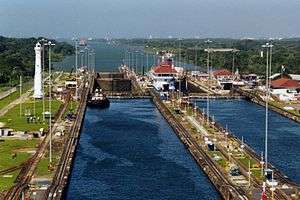Ship canal

A ship canal is a canal especially intended to accommodate ships used

A ship canal is a canal especially intended to accommodate ships used on the oceans, seas or lakes to which it is connected, as opposed to a barge canal intended to carry barges and other vessels specifically designed for river and/or canal navigation. Because of the constraints of accommodating vessels capable of navigating large bodies of open water, a ship canal typically offers deeper water and higher bridge clearances than a barge canal of similar vessel length and width constraints.
Ship canals may be specially constructed from the start to accommodate ships, or less frequently they may be enlarged barge canals, or canalized or channelized rivers. There are no specific minimum dimensions for ship canals, with the size being largely dictated by the size of ships in use nearby at the time of construction or enlargement.
Ship canals may be constructed for a number of reasons, including:
- To create a shortcut and avoid lengthy detours.
- To create a navigable shipping link between two land-locked seas or lakes.
- To provide inland cities with a direct shipping link to the sea.
- To provide an economical alternative to other options.
on the oceans, seas or lakes to which it is connected, as opposed to a barge canal intended to carry barges and other vessels specifically designed for river and/or canal navigation. Because of the constraints of accommodating vessels capable of navigating large bodies of open water, a ship canal typically offers deeper water and higher bridge clearances than a barge canal of similar vessel length and width constraints.
Ship canals may be specially constructed from the start to accommodate ships, or less frequently they may be enlarged barge canals, or canalized or channelized rivers. There are no specific minimum dimensions for ship canals, with the size being largely dictated by the size of ships in use nearby at the time of construction or enlargement.
Ship canals may be constructed for a number of reasons, including:
- To create a shortcut and avoid lengthy detours.
- To create a navigable shipping link between two land-locked seas or lakes.
- To provide inland cities with a direct shipping link to the sea.
- To provide an economical alternative to other options.
Navigability
The standard used in the European Union for classifying the navigability of inland waterways is the European Agreement on Main Inland Waterways of International Importance (AGN) of 1996, adopted by The Inland Transport Committee of the United Nations Economic Commission for Europe (ECE), which defines the following classes:[1][2] (This table is incomplete.)
| Class | Tonnage (t) | Draught (m) | Length (m) | Width (m) | Air Draught (m) | Description |
|---|---|---|---|---|---|---|
| Class III | 1,000 | |||||
| Class IV | 1,000–1,500 | 2.5 | 80–85 | 9.5 | 5.2–7.0 | Johann Welker[1] |
| Class Va | 1,500–3,000 | 2.5–2.8 | 95–110 | 11.4 | 5.2–7.0–9.1 | Large Rhine[1] |
| Class VIb | 6,400–12,000 | 3.9 | 140 | 15 | 9.1 | [1] |
| Class VII | 14,500–27,000 | 2.5–4.5 | 275–285 | 33.0–34.2 | 9.1 | [1] |
See also
References
- 1 2 3 4 5 "European Agreement on the main Inland Waterways of international importance (AGN)" (PDF). 2072, I-35939. United Nations: 343. Retrieved 2008-11-30.
- ↑ previous ref apparently broken (May 2016): alternative reference to document with the same name containing similar tabular information at unece.org
| Wikimedia Commons has media related to Canal. |